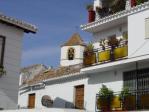 |
 |
 |
 This surprising and picturesque La Axarquía village stretches across one of the slopes of the looming Sierra de Tejeda range, while its municipal territory extends to the vicinity of the La Maroma peak (2,065 metres), considered the “Roof of Málaga”.The visitor arriving in this region finds himself immersed in a landscape that is simply spectacular, both for the mountains themselves and for the panoramic views to be seen from every point. A pine forest, broken by rocky expanses on its upper levels, covers the northern part while in the south the landscape has more in common with the dominant terrain of La Axarquía, although it does not cease to be rugged. Here one sees hills covered with vineyards and olive groves, occasionally mixed with fruit and citrus orchards and market gardens.
This surprising and picturesque La Axarquía village stretches across one of the slopes of the looming Sierra de Tejeda range, while its municipal territory extends to the vicinity of the La Maroma peak (2,065 metres), considered the “Roof of Málaga”.The visitor arriving in this region finds himself immersed in a landscape that is simply spectacular, both for the mountains themselves and for the panoramic views to be seen from every point. A pine forest, broken by rocky expanses on its upper levels, covers the northern part while in the south the landscape has more in common with the dominant terrain of La Axarquía, although it does not cease to be rugged. Here one sees hills covered with vineyards and olive groves, occasionally mixed with fruit and citrus orchards and market gardens.
To the twenty-first century mind the location of the village has to seem arbitrary, but the fact is that its placement is due to two factors that were crucial in the Middle Ages: abundant water in the area and, if the need should arise, the possibility of serving either as a safe refuge or as a strong natural defensive position.Remains discovered in the region known as La Fáfara show the presence of primitive man in this territory, and it should be kept in mind that it is relatively close to the Boquete Zafarraya (Zafarraya Gap), a natural pass from the most remote antiquity between the coast and the interior of the Peninsular. It is also more than probable that both the Phoenicians and Romans passed through this area since they did through others very close to here. Nevertheless, one must look for the origin of the village as such to the Arabic era, when the first nucleus of population, Canillas Azzeitún, was created.
The village preserves this name with a slight variation. It is known that it belonged to the Kingdom of Granada, but the exact date of its conquest by the Christian troops is unknown. The Moorish rebellion, however, is very well documented, especially a strange occurrence in which romantic, political and military factors interacted.The chronicles state that a Moor named Al Muezzín, who assisted the Alpujarreños in the famous sixteenth century uprising, came to Canillas looking for his wife who at the time was the slave of a Christian. Al Muezzín promoted the uprising in Canillas de Aceituno and some of its men, emboldened by the cause, killed eight Christians who happened to be in an inn. Upon being informed of the act, the Judge of Vélez imprisoned an unknown number of Moors and tortured and stripped them of their possessions, thus causing the uprising to become generalised. Once it was put down, the Moors were expelled from the village and the castle was destroyed by orders of Felipe II.
The locality was repopulated by Christians from Archidona, Antequera, Lucena and Cabra, and apparently also from Andújar. This would explain the devotion to the Virgen de la Cabeza, who is the patron saint of both Canillas de Aceituno and of Andujar.
 |
 |
 |
| Surface Area: | 42 square kilometres |
| Population: | about 2,000 |
| What the natives are called: | Canilleros |
| Monuments: | the Nuestra Señora del Rosario church, Casa de los Diezmos (Tithe House), and the medieval cistern |
| Geographical Location: | in the northeast part of the La Axarquía region, 17 kilometres from Vélez Málaga and 51 from the provincial capital. The village sits at 650 metres above sea level. Its average rainfall is 670 litres per square metre and the annual average temperature is 17º C. |
| Tourist Information: | Town Hall, Plaza de la Constitución, 1 (29716). |
| Telephone: |
952 518 002 |



















